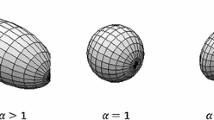Abstract
Although micro-dilatation theory is very suitable and effective in modeling elastic porous materials, the absence of any guidance to evaluate or characterize its porosity-related parameters in the literature limited its use and applicability. This paper is proposing a methodology to characterize two of such important parameters, namely porosity change stress parameter and void stiffness coefficient, in terms of microstructural details such as average void radius and density of voids. Two numerical experiments were used to characterize these parameters, and results were validated by a comparison with a high-resolution finite element model of the microstructure with voids explicitly considered.
Similar content being viewed by others
References
Cowin, S.C., Nunziato, J.W.: Linear elastic materials with voids. J. Elast. 13, 125–147 (1983)
Scalia, A., Sumbatyan, M.A.: Contact problem for porous elastic half-plane. J. Elast. 60, 91–102 (2000)
Scalia, A.: Contact problem for porous elastic strip. Int. J. Eng. Sci. 40, 401–410 (2002)
Atkin, R.J., Cowin, S.C., Fox, N.: On boundary conditions for polar materials. ZAMP 28, 1017–1026 (1977)
Chandrasekharaiah, D.S.: Effects of surface stresses and voids on Rayleigh waves in an elastic solid. Int. J. Eng. Sci. 25, 205–211 (1987)
Ciarletta, M., Iovane, G., Sumbatyan, M.A.: On stress analysis for cracks in elastic materials with voids. Int. J. Eng. Sci. 41, 2447–2461 (2003)
Ramézani, H., Steeb, H., Jeong, J.: Analytical and numerical studies on Penalized Micro-Dilatation (PMD) theory: macro-micro link concept. Eur. J. Mech. A/Solids 34, 130–148 (2012)
Bishay, P.L., Sladek, V., Gao, X.W., Sladek, J.: Analysis of elastic media with voids using new mixed-collocation finite element method (MCFEM). J. Eng. Mech. (2016). doi:10.1061/(ASCE)EM.1943-7889.0001193
Eringen, A.C.: Microcontinuum Field Theories. Springer, New York (1999)
Eringen, A.C., Suhubi, E.S.: Nonlinear theory of simple micro-elastic solids-I. Int. J. Eng. Sci. 2, 189–203 (1964)
Iesan, D., Quintanilla, R.: Existence and continuous dependence results in the theory of microstretch elastic bodies. Int. J. Eng. Sci. 32, 991–1001 (1994)
Iesan, D., Pompei, A.: On the equilibrium theory of microstretch elastic solids. Int. J. Eng. Sci. 33, 399–410 (1995)
Iesan, D., Nappa, L.: Extremum principles and existence results in micromorphic elasticity. Int. J. Eng. Sci. 39, 2051–2070 (2001)
Cosserat, E., Cosserat, F.: Theorie des Corps Deformables. A. Hermann, Paris (1909)
Rosenberg, J., Cimrman, R.: Microcontinuum approach in biomechanical modeling. Math. Comput. Simul. 61, 249–260 (2003)
Walsh, S.D.C., Tordesillas, A.: Finite element methods for micropolar models of granular materials. Appl. Math. Model. 30, 1043–1055 (2006)
Forest, S.: Micromorphic approach for gradient elasticity, viscoplasticity, and damage. J. Eng. Mech. ASCE 135, 117–131 (2009)
Forest, S., Aifantis, E.C.: Some links between recent gradient thermo-elastoplasticity theories and the thermomechanics of generalized continua. Int. J. Solids Struct. 47, 3367–3376 (2010)
Isaksson, P.: A note on stress fields and crack growth in porous materials subjected to a contact load. Int. J. Solids Struct. 64–65, 62–70 (2015)
Iovane, G., Nasedkin, A.V.: Finite element analysis of static problems for elastic media with voids. Comput. Struct. 84, 19–24 (2005)
Thurieau, N., Njiwa, R.K., Taghite, M.: The local point interpolation-boundary element method (LPI-BEM) applied to the solution of mechanical 3D problem of a micro-dilatation medium. Eur. J. Mech. A/Solids 47, 391–399 (2014)
Sladek, J., Sladek, V., Repka, M., Bishay, P.L.: Static and dynamic behavior of porous elastic materials based on micro-dilatation theory: a numerical study using the MLPG method. Int. J. Solids Struct. 96, 126–135 (2016)
Jenkins, J.T.: Static equilibrium of granular materials. J. Appl. Mech. 42, 603–606 (1975)
Puri, P., Cowin, S.C.: Plane waves in linear elastic materials with voids. J. Elast. 15, 167–183 (1985)
Author information
Authors and Affiliations
Corresponding author
Rights and permissions
About this article
Cite this article
Bishay, P.L., Repka, M., Sladek, V. et al. On the characterization of porosity-related parameters in micro-dilatation theory. Acta Mech 228, 1631–1644 (2017). https://doi.org/10.1007/s00707-016-1789-9
Received:
Revised:
Published:
Issue Date:
DOI: https://doi.org/10.1007/s00707-016-1789-9




